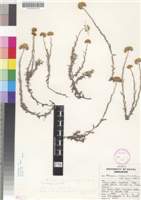Common names:
Yellow-tipped straw-flower, impepho (Z)
Origin of name:
cymosus /-a/-um = with flowers in clusters opening from the centre outwards; flat-topped flower clusterscalvum = hairless; refers to the lack of pappus
Diagnostic characters:
Yellow straw bractsSmall compact heads on short stalks
Description:
A well-branched spreading subshrub up to 1 m tall, branches long, often decumbent at the base then erect, thinly greyish-white woolly, densely leafy, becoming pedunculoid upwards. Leaves very variable, mostly 8-15 (-45) x 2-4 (-15) mm, becoming smaller and more distant upwards, elliptic-oblong or linear-oblong, apex acute, sometimes acuminate, mucronate, slightly narrowed to a half-clasping, subdecurrent base, margins flat or subrevolute, upper surface clothed in thin silvery grey sericeous indumentum that will strip like a skin (and sometimes does), rarely woolly-felted, lower surface closely white-woolly. Heads heterogamous or sometimes homogamous, cylindric, mostly c. 3 x 1 mm, sometimes up to 4.5 x 3 mm, many in compact cymes corymbose-paniculately arranged at the branch tips. Involucral bracts in c. 4 series, graded, closely imbricate, inner about equaling flowers, not radiating, translucent, glossy, bright canary-yellow, tips generally smooth. Receptacle with fimbrils exceeding the ovaries. Flowers 6-12 (-20), 0-4 female, 3-12(-20) homogamous, yellow. Achenes 0.75 mm, broadly cylindric, glabrous. Pappus bristles many, scabrid, bases cohering strongly by patent cilia.
Flowers from December to March.
Distribution:
Forms low, spreading clumps in stony grassland or on steep turf slopes, between 1 200 and 3 170 m above sea level. At high altitudes the plants are, not unexpectedly, much more compact than typical H. cymosum from the coast, but at lower altitudes the two look so much alike that dissection is needed to separate them. Subsp. calvum ranges along the Drakensberg from about Saalboom Nek, Barkly Pass and Maclear in the E. Cape, along the KwaZulu-Natal-Lesotho border to the low Berg near Volksrust and Wakkerstroom in Mpumalanga and around Ficksburg and Harrismith in the Free State, and Maseru, Berea and Butha Buthe districts in Lesotho; also on Ngeli Mt on the Eastern Cape-KwaZulu-Natal border and the mountain spurs running out to Greytown and Nkandhla in KwaZulu-Natal.
Grassland Biome.
Notes:
Differs from typical H. cymosum in its generally more crowded and often narrower leaves, smaller heads (4�7 flowers in a head, against 6�12), generally shorter fimbrils (about as long as the ovary, against about two and a half times as long), and lack of pappus bristles. It can be confused with H. griseolanatum and H. infaustum, but is easily distinguished by its glabrous ovaries.
Two subspecies are recognized:
1a Heads with 6�20 flowers, fimbrils more than twice as long as ovary, pappus copious
(a) subsp. cymosum
1b Heads with 4�7 flowers, fimbrils about as long as ovary, pappus wanting
(b) subsp. calvum
Taxonomy:
Literature:
Helichrysum cymosum (L.) D. Don subsp. calvum Hilliard in Notes R. bot. Gdn Edinb. 32,3: 346 (1973); Compositae in Natal 169 (1977).
Type:
KwaZulu-Natal-Lesotho border, summit of Drakensberg in vicinity of Bushman's River pass, c. 3050 m, Wright 447 (E, holo.; NU, iso.).
Synonym(s):
H. infaustum var. discolor Moeser in Bot. Jb. 44: 246 (1910). Types: KwaZulu-Natal, Cooper 2592 (K); Greytown, Wood 1013 (BM, E) and 4323 (G, K, Z); Transvaal, Sandspruit, Rehmann 6872 (K, Z).
Vouchers:
Acocks 20176 (PRE); Devenish 829 (PRE); Hilliard & Burtt 6678 (E; K; MO; NU; PRE; S).

_sml.jpg)
_sml.jpg)
_sml.jpg)
_sml.jpg)
_sml.jpg)
_sml.jpg)

